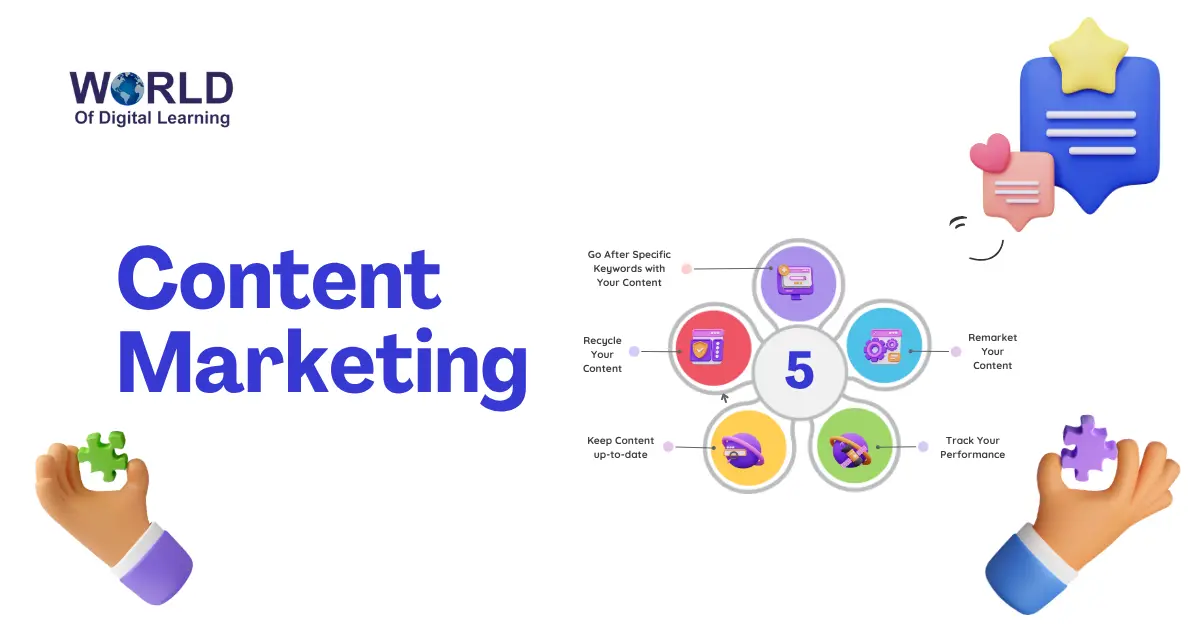Content marketing is a strategic approach that focuses on creating and distributing valuable, relevant, and consistent content to attract and retain a clearly defined audience. It aims to build trust, establish brand authority, and influence customer behavior, ultimately driving profitable business actions. One of the main advantages of content marketing is its cost-effectiveness—creating quality content costs less than traditional advertising and continues to deliver value over time. It enhances SEO by increasing organic visibility, helps generate more leads, and builds long-term customer loyalty. Additionally, content marketing educates the audience by addressing their pain points and providing useful information, which encourages informed purchase decisions. This strategy also strengthens brand credibility and differentiates a business from competitors. By consistently engaging their target audience with relevant content, brands can foster deeper connections and achieve sustainable growth in today’s digital landscape.
Table of Contents
Content Generation Strategies
Content generation strategies focus on creating relevant, valuable, and consistent content to attract and engage the target audience effectively. Key strategies include understanding your audience deeply by researching their needs, preferences, and pain points to tailor content that resonates. Planning content with calendars ensures regular uploads and timely topics, which keeps the audience engaged. Diversifying content types—such as blogs, videos, infographics, podcasts, and social media posts—caters to different consumption preferences. Keyword research and SEO optimization improve visibility and organic reach. Content promotion is equally vital, involving sharing across various platforms and collaborating with influencers or partners to expand reach. Data-backed content helps build trust and authority, while clear calls-to-action guide audience interaction and conversions. Monitoring analytics allows continuous refinement of strategies to maximize impact. Altogether, these approaches create a robust content ecosystem that drives engagement, builds brand authority, and supports business goals.
Writing Content for Search Engines
Writing content for search engines involves creating valuable, relevant, and well-structured material that meets both user needs and SEO best practices. The primary goal is to optimize your content so it ranks higher in search engine results without sacrificing readability for your audience. Start by conducting keyword research to identify terms your target audience is searching for, then naturally incorporate these keywords into titles, headings, and throughout the body of the text. Avoid keyword stuffing, which can harm rankings and deter readers. Structuring content with clear subheadings and short paragraphs improves readability and user experience. Including multimedia elements like images and videos can also boost engagement. Quality and originality are essential—content should provide comprehensive, accurate information that addresses the user’s intent. Writing in a conversational tone helps maintain audience interest, while SEO optimization ensures your content reaches the right people, driving organic traffic and building authority. This balance is key to successful SEO writing.
How to do Content Spinning
Content spinning is a technique used to create multiple unique versions of the same original content by replacing words, phrases, or sentences with synonyms or alternative structures. This process can be done manually by a writer or automatically using spinning software. The goal is to produce different texts that convey the same meaning to avoid duplicate content penalties and improve SEO by populating multiple web pages with similar but distinct content. While content spinning can save time and reduce costs, it should be used carefully, as poorly executed spins often result in low-quality, confusing articles that can harm reader experience and website credibility. Effective content spinning requires a balance between maintaining original meaning and creating readable, natural-sounding variations. It is often used to quickly generate search engine-optimized content, but it should be backed by a strong strategy to avoid negative impacts on site reputation.
Tools for Plagiarism Checkers
Tools for plagiarism checking are essential for ensuring original and authentic content in writing. Popular tools include Grammarly, which uses advanced AI to scan texts against billions of web pages and academic databases, providing an originality score and citation help. Copyscape offers real-time plagiarism detection, highlighting copied sentences and linking to original sources, widely used by bloggers and editors. Quetext features a DeepSearch technology for thorough plagiarism detection, along with citation building and paraphrasing assistance. iThenticate is trusted by researchers and publishers for its precise plagiarism detection capabilities. Other notable tools include Prepostseo and DupliChecker, which offer free and premium versions for scanning content of various sizes. AI-powered features in these tools help detect not just direct copying but also paraphrased and AI-generated content. Using these plagiarism checkers prevents content duplication, protects the author’s reputation, and maintains academic or professional integrity effectively.
Learn what Content feeding is for Search Engines
Content feeding for search engines refers to the systematic process of providing fresh, relevant, and well-structured content that search engine crawlers can efficiently discover, crawl, and index. Search engines use automated programs called crawlers or spiders to explore the web, following links and analyzing web pages’ content and metadata. For content feeding to be effective, websites must ensure their content is easily accessible, uses proper HTML tags, optimized keywords, and structured data to help search engines understand the topic and relevance. This feeding process helps search engines update their indexes regularly, which impacts how frequently and prominently a website appears in search results. Well-fed content that aligns with search engine algorithms meets user intent better, improving organic rankings. Correct content feeding involves continuous updates and optimization so that search engines perceive the site as authoritative and valuable for users’ search queries, thereby boosting visibility and traffic.
Content Writing Team Management for Clients
Managing a content writing team for clients requires clear communication, defined roles, and efficient collaboration. It starts with setting specific goals, project deadlines, and quality standards tailored to the client’s needs. Effective team management involves assigning roles such as content strategists, writers, editors, and SEO specialists, ensuring accountability and expertise in each task. Utilizing project management tools like Asana, Trello, or Slack helps organize workflows, monitor progress, and maintain deadlines seamlessly. Encouraging open communication fosters creativity and timely problem-solving, while regular training keeps the team updated on industry trends and client expectations. Establishing content guidelines ensures consistency in tone, style, and branding across client projects. Periodic performance reviews and feedback sessions help improve output quality and motivation. Finally, fostering a positive work culture with recognition and teamwork strengthens motivation and leads to consistently high-quality content delivery, ensuring client satisfaction and successful project outcomes.
Content writing for Blogs
Content writing for blogs involves creating engaging, valuable, and well-structured content tailored to the target audience’s needs. A strong blog post starts with a compelling headline and introduction that grabs readers’ attention and encourages them to read further. Organizing content with clear subheadings and short paragraphs improves readability, while using lists, visuals, and examples keeps the audience engaged. Researching the topic thoroughly ensures accuracy and relevance. SEO optimization through keyword integration and internal and external linking helps improve search engine rankings. Writing in a conversational tone makes the content more relatable, and including a call-to-action directs readers to take desired steps such as subscribing or sharing. Consistency in publishing builds audience trust and loyalty over time. Overall, effective blog content balances informative value with reader engagement, enhancing both visibility and user experience for sustained web traffic growth.
Content Writing For Adsense
Content writing for AdSense requires creating high-quality, original, and valuable content that complies with Google AdSense policies. The key is to write well-researched blog posts or articles, typically 800 to 1,000 words or more, that provide useful information to readers while maintaining relevance to your niche. Content must be unique, free from plagiarism, and avoid excessive ads or pop-ups, as a positive user experience is crucial for approval. Proper keyword usage and SEO-friendly formatting improve visibility and attract organic traffic, which is essential for generating ad revenue. Consistency in publishing regularly updated content also signals activity and credibility to Google. Additionally, organizing content with clear headings, engaging introductions, and calls-to-action helps retain users. Overall, successful AdSense content balances quality with compliance, ensuring that your site meets Google’s standards for monetization while delivering real value to your audience for sustained earnings.
Content writing for Portals, Email & Paid Campaigns
Content writing for portals, emails, and paid campaigns requires a tailored approach to effectively engage diverse audiences and meet specific marketing goals. Writing for portals focuses on creating clear, concise, and informative content that caters to a broad audience, often using structured formats with headings, lists, and links for easy scanning. Email content must be personalized, attention-grabbing, and action-oriented, with compelling subject lines, concise body text, and strong calls-to-action to boost open and click-through rates. Paid campaign content demands persuasive, benefit-driven writing that aligns with the target audience’s needs and motivates conversions quickly, often within character limits. Across all formats, understanding audience preferences, maintaining brand voice, and optimizing for SEO, where applicable, are critical. Consistency, clarity, and engagement drive success, helping build trust and encourage interaction, ultimately contributing to higher ROI and stronger client relationships.
Content Generation Networks
Content Generation Networks (CGNs) refer to organized systems or platforms where content is produced, curated, and distributed on a large scale to meet diverse audience needs across various channels. These networks often involve collaborations among writers, editors, designers, and marketers who generate consistent and relevant content tailored to different niches or industries. CGNs can include freelance writing platforms, content mills, or specialized agencies that deliver bulk content efficiently. Their role is vital in supporting digital marketing, SEO strategies, and brand communication by producing optimized articles, blogs, social media posts, and multimedia content rapidly. The networks leverage technology to coordinate workflows, maintain content quality, and ensure timely delivery to clients or publishers. Additionally, CGNs help maximize reach and engagement by distributing content strategically across platforms, thus enhancing visibility and traffic. Effective content generation networks are adaptable, scalable, and essential in today’s fast-paced content-driven digital landscape.

 September 30, 2025
September 30, 2025  9 Min
9 Min  No Comment
No Comment 